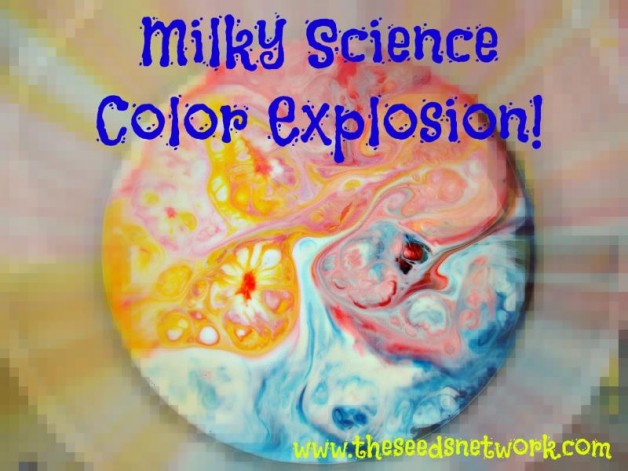This is a great scientific experiment to do with young children to talk about how different liquids react, and to learn about color names and color blending.
First, we poured milk into a shallow bowl. Using three different food colors – we placed a drop or two of each on opposite ends of the bowl. Be sure to add the drops carefully, so they don’t splash.

Then, we dipped Q-tips into some dish soap, and placed the soapy end onto one of the dots of color. As soon as the soap hit the milk it reacted and caused the colors to seemingly “explode” in the bowl of milk. (Steve Spangler Science gives a good scientific explanation as to WHY this happens).
We dipped the Q-tip a few times in the milk onto the other dots to see the reaction. But after that, once the soap is introduced, the explosive effect is lessened. But the milk still slowly moved around for awhile, and this was a good opportunity to talk about the colors mixing together. In our experiment, we used the primary colors (red-yellow-blue) to see the effects of blending to form secondary colors (orange-green-purple).

In true scientific fashion, we asked our preschoolers to record and document the results of the experiment by having them draw what they saw happening in the bowl. This will gave them more time to look at the colors continue to blend, and we talked about what was happening and the colors we saw forming. (You can use our “Milky Science” worksheet, make one of your own, or simply provide paper and crayons to have children document their experiment).

We paired this activity with the book “Mouse Paint” by Ellen Stoll Walsh, which introduces color concepts when three white mice jump into three jars of paint!
Extending the activity: Our preschoolers asked questions of what would happen if we put in something OTHER than soap into the bowl of colorful milk (some of their ideas were salt, water and apple juice). So we took their lead and tried some other things – which is a good time to ask them “what-if” questions, and learn about how other solids and liquids reacted with the milk. So, you can prepare this activity with that in mind and bring in other ingredients to add to the milk and see what happens!




Leave a Reply